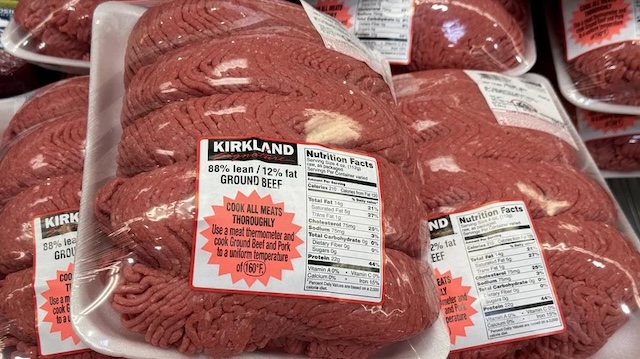Ground beef is a staple in many kitchens, but seeing it look anything other than bright red can be concerning. We’ve all probably come across this situation—opening a package of ground beef, only to notice it has a grayish hue. This raises questions about whether it’s still safe to eat. Understanding why this color change happens can help you decide if the meat is still usable or if it’s time to throw it out. Here’s everything you need to know about gray ground beef and food safety.
The Common Concern with Gray Ground Beef
If you’ve ever brought home a package of ground beef that looks gray, you’re not alone. Many people assume that gray meat is spoiled and should be discarded immediately. The bright red color we associate with fresh ground beef often influences our perception of its quality. When meat deviates from this color, it naturally raises concerns. However, gray ground beef is not always a sign of spoilage. To understand when it’s safe and when it’s not, let’s dive deeper into what causes these color changes.

Understanding Oxymyoglobin and Color Changes in Meat
The color of ground beef is largely due to a protein called myoglobin, which reacts with oxygen. When meat is exposed to air, myoglobin combines with oxygen to form oxymyoglobin, giving it a bright red color that we often associate with freshness. However, ground beef at the center of a package might not be exposed to oxygen as readily, which can result in a gray or brownish color.
This lack of oxygen doesn’t necessarily mean the meat is spoiled; it simply means the inner portions haven’t had the same oxygen exposure as the outer layers. When you cut open the package and expose the gray areas to air, they might even turn red after a few minutes. Therefore, gray ground beef is sometimes just a result of limited oxygen exposure rather than an indication of spoilage.
When Gray Ground Beef Is Safe to Eat
It’s important to know that gray color in ground beef isn’t always a red flag. If the grayish hue is only in the middle, and the meat smells normal and doesn’t show any other signs of spoilage, it’s likely safe to use. Fresh ground beef should have a relatively neutral smell; it shouldn’t smell sour, rancid, or “off” in any way. A slightly gray or brown middle section in ground beef is typically safe, as long as it hasn’t been stored past its expiration date and has been kept refrigerated properly.
Quick tips for safe consumption:
- Check the Smell: Fresh ground beef should have a mild scent. If it smells strange or unpleasant, it’s best to err on the side of caution.
- Examine the Texture: Fresh ground beef should be firm to the touch. If it feels slimy or sticky, this could be a sign of bacterial growth.
- Check Expiration Dates: Always follow the “use by” date on the packaging, and make sure to refrigerate the meat promptly after purchase.

When to Toss Gray or Brown Ground Beef
Although gray in the middle of the ground beef package can be safe, there are cases where discoloration should not be ignored. If the entire package has turned gray or brown, or if the outer edges of the meat appear gray or brown, it’s best to discard it. This type of discoloration may indicate that the meat has been exposed to air for too long, causing oxidation, or that it is starting to spoil.
Additionally, if there is any foul odor, slimy texture, or if the beef has been in the refrigerator for more than a couple of days past its expiration, it’s safer to throw it out. Spoiled meat can harbor harmful bacteria such as E. coli, Salmonella, or Listeria, which can cause food poisoning. When it comes to meat safety, it’s better to be safe than sorry.
Signs that ground beef has gone bad:
- Bad Odor: If it has a sour, tangy, or off-putting smell, this is a clear indication of spoilage.
- Unusual Texture: Slimy or sticky ground beef is a sign that bacteria have started to grow.
- Widespread Gray or Brown Color: If the majority of the meat appears gray or brown, it’s likely best to discard it.

Additional Tips for Checking Meat Freshness
Aside from color, there are other indicators to help ensure that your ground beef is fresh and safe. For instance, keeping an eye on the packaging date and storing it correctly can extend its shelf life. Here are a few more tips to help you feel confident about your ground beef:
- Storage Matters: Ground beef should be stored at 40°F or below in the refrigerator. If you’re not planning to use it within two days, consider freezing it to maintain its quality.
- Proper Thawing: When defrosting frozen ground beef, do so in the refrigerator, not at room temperature, to avoid bacterial growth.
- Cook Thoroughly: Always cook ground beef to an internal temperature of 160°F to kill any potential bacteria.
By following these tips, you can avoid unnecessary waste while also ensuring that the meat you consume is safe.

Final Thoughts on Gray Ground Beef
While it’s natural to be concerned when ground beef looks gray, understanding why this color change happens can help you make safer choices in the kitchen. Often, gray beef is simply the result of limited oxygen exposure, especially if it’s only in the middle of the package. However, when in doubt, trust your senses—if the smell, texture, or appearance seems off, it’s best to throw it out. By following these guidelines, you’ll be able to determine when ground beef is safe to eat and when it’s time to toss it.
Remember, food safety is always a priority, and taking the time to check your ground beef can help protect you and your loved ones from potential foodborne illnesses. Enjoy cooking with confidence, knowing that you’re making safe and informed choices with your ingredients.



